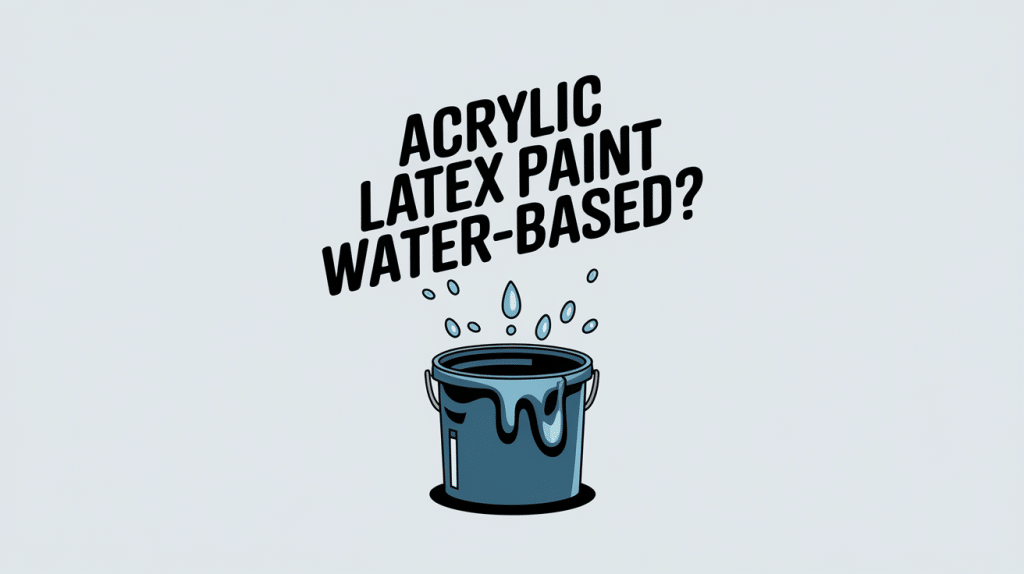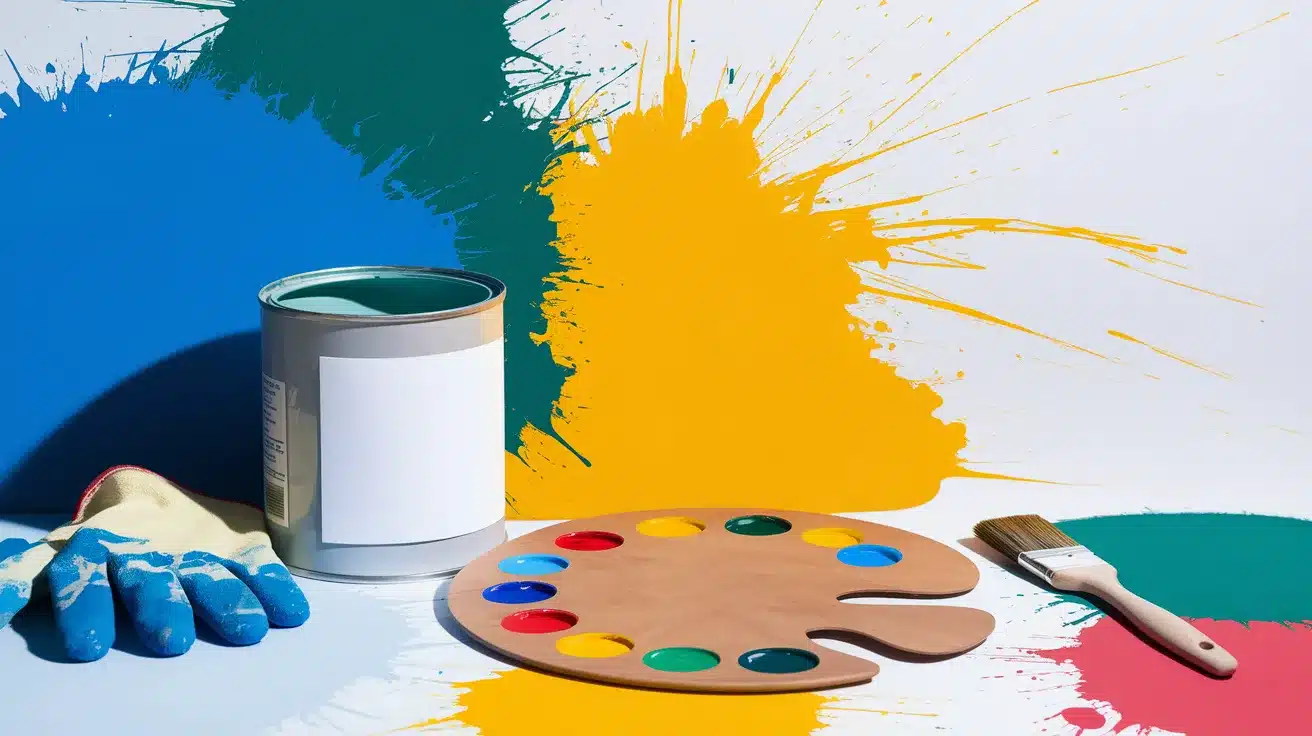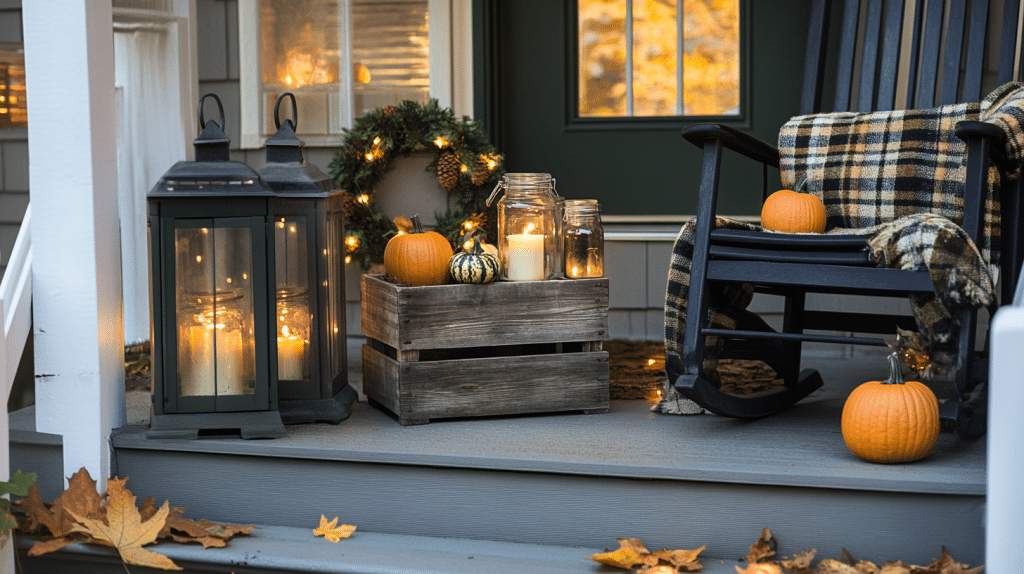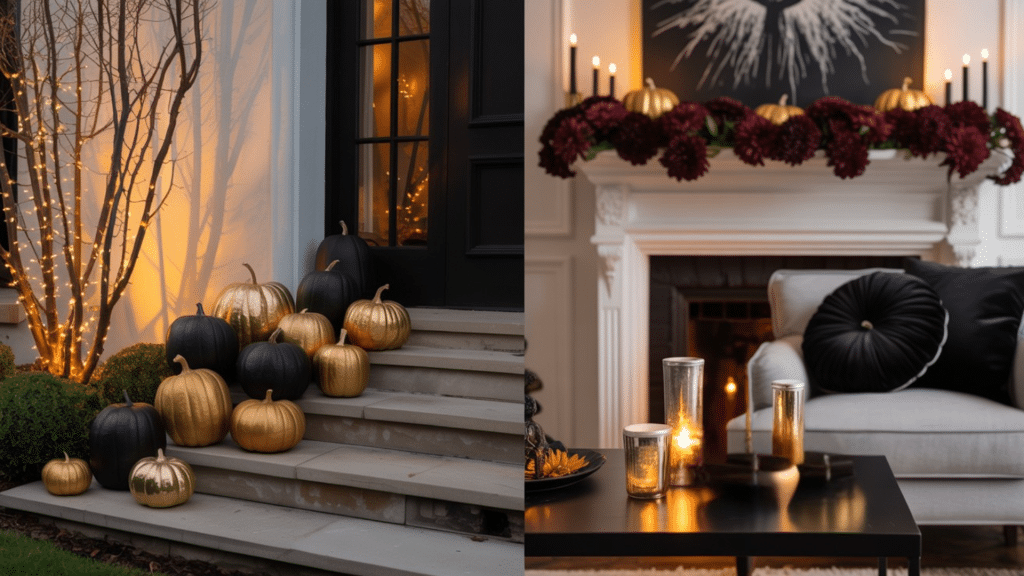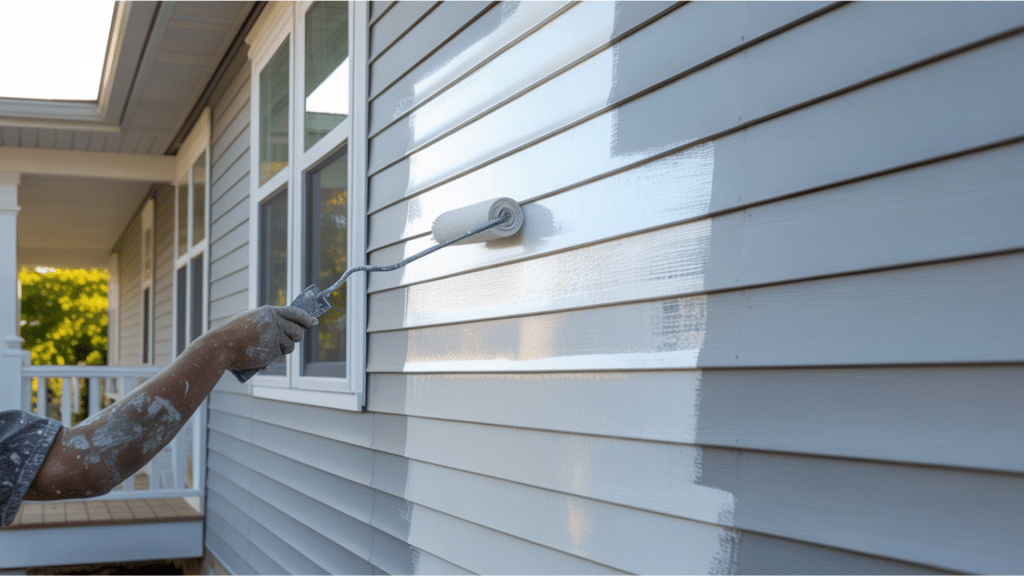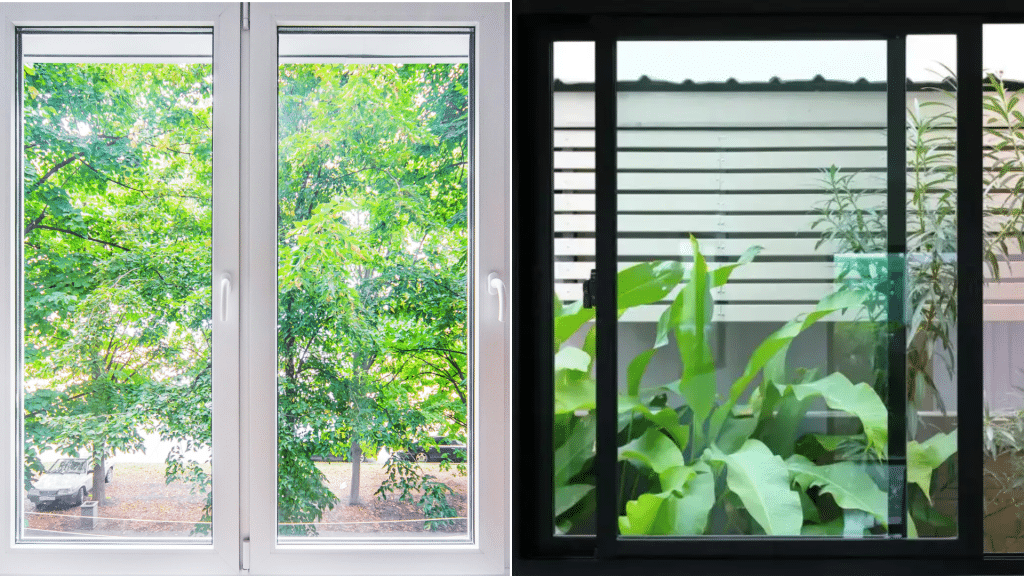Standing in the home improvement store, you stare at rows of paint cans with terms like “acrylic,” “latex,” and “water-based” on the labels.
You want to paint your living room, but now you’re second-guessing what type of paint to buy. Is acrylic latex paint water-based? The confusion is real and frustrating.
Here’s some clarity! Acrylic latex paint is indeed water-based, despite the somewhat misleading name.
This popular paint choice combines acrylic and latex resins suspended in water rather than solvents. It’s the go-to option for most indoor and many outdoor projects today.
In this blog, I’ll explain what makes acrylic latex paint water-based, why it matters for your projects, and how this knowledge can help you make better painting decisions.
What is Acrylic Latex Paint?
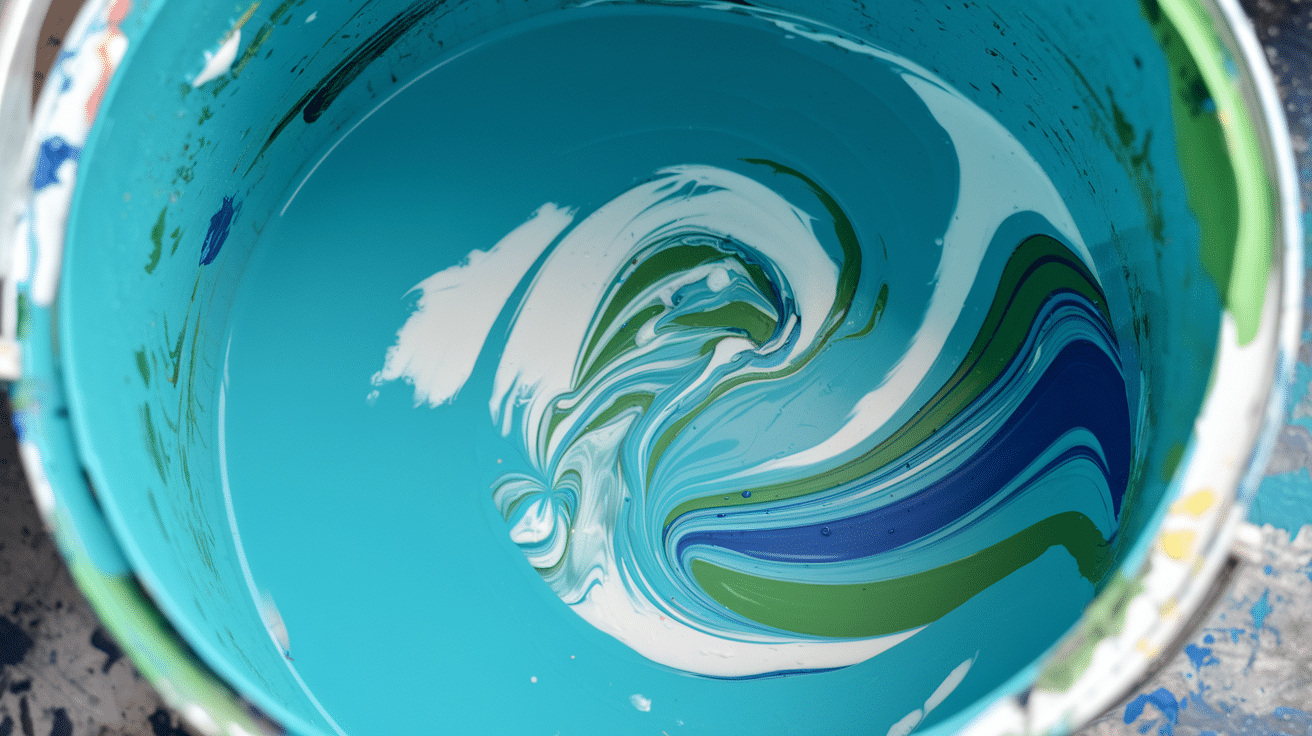
Acrylic latex paint is a water-based paint that combines acrylic resins with latex polymers. It’s one of the most common types of paint used for homes, both inside and outside.
The name might sound complex, but the concept is straightforward – it’s essentially plastic (acrylic) particles suspended in water.
When you apply acrylic latex paint to a surface, the water evaporates, leaving behind a solid, durable film of color. This paint type has become popular because it’s easy to use, dries quickly, produces fewer odors than oil-based alternatives, and cleans up with just soap and water.
Is Acrylic Latex Paint Waterproof?
Acrylic latex paint is water-resistant but not completely waterproof. It can handle splashes and occasional moisture, making it good for bathrooms and kitchens.
Exterior versions contain additives to withstand rain and humidity. For truly waterproof needs, consider 100% acrylic paint or adding a waterproof sealer on top.
Water-Based vs Oil-Based Paint: Key Differences
When choosing between water-based and oil-based paints, it’s essential to understand their key differences.
Water-based paints dry faster, emit fewer odors, and are easier to clean up, making them ideal for interior walls and ceilings.
In contrast, oil-based paints offer a more durable, glossy finish suitable for high-traffic areas but require longer drying times and involve more complex cleanup.
| Aspect | Water-Based Paint | Oil-Based Paint |
|---|---|---|
| Composition | Uses water as the primary solvent. | Utilizes organic solvents like mineral spirits or turpentine. |
| Drying Time | Dries quickly, often within a few hours. | Takes longer to dry, typically 16-24 hours between coats. |
| Odor | Low odor due to fewer volatile organic compounds (VOCs). | Strong odor because of higher VOC content. |
| Durability | Less durable; may require more frequent touch-ups. | Forms a hard, durable finish suitable for high-traffic areas. |
| Color Retention | Resists yellowing over time; maintains color well. | Prone to yellowing, especially in low-light areas. |
| Cleanup | Easy cleanup with soap and water. | Requires solvents like turpentine or mineral spirits for cleanup. |
| Environmental Impact | Lower VOCs make it more environmentally friendly. | Higher VOCs contribute to environmental concerns. |
| Application | Easier to apply; quick drying can make blending challenging. | Longer drying time allows for smoother blending and finish. |
| Finish | Typically offers a less glossy finish. | Provides a high-gloss finish. |
| Best Use Cases | Interior walls and ceilings, areas where quick drying and low odor are priorities. | Trim, doors, and areas requiring a durable, glossy finish. |
Acrylic vs Latex vs Acrylic Latex
When discussing paint options, understanding the differences between acrylic, latex, and acrylic latex paint is important for selecting the right product for your project.
What is Acrylic Paint?
Acrylic paint uses acrylic resin as its binding agent. This makes it highly durable, flexible, and resistant to cracking and peeling. It adheres well to many surfaces and offers excellent color retention.
Acrylic paint is water-resistant once dry and works well for exterior applications. It tends to be more expensive than other options but provides long-lasting results.
What is Latex Paint?
Latex paint is water-based with rubber particles as binders. Traditional latex paint (which is actually becoming rare) offers good coverage, dries quickly, and is easy to clean up with just water.
It has a low odor and releases fewer VOCs compared to oil-based paints. However, it’s not as durable as acrylic and may not perform as well in high-moisture areas.
What is Acrylic Latex Paint?
Acrylic latex paint combines features of both. It’s water-based like latex but contains acrylic resins instead of rubber particles.
This creates a paint that’s easy to use like latex but offers improved durability and adhesion like acrylic.
It’s the most common type of paint sold today for both interior and exterior use, providing a good balance of quality and value. Many paints labeled simply as “latex” in stores today are actually acrylic latex paints.
When choosing between these options, consider your specific needs regarding durability, location (interior vs exterior), surface type, and budget.
Where and When to Use Acrylic Latex Paint
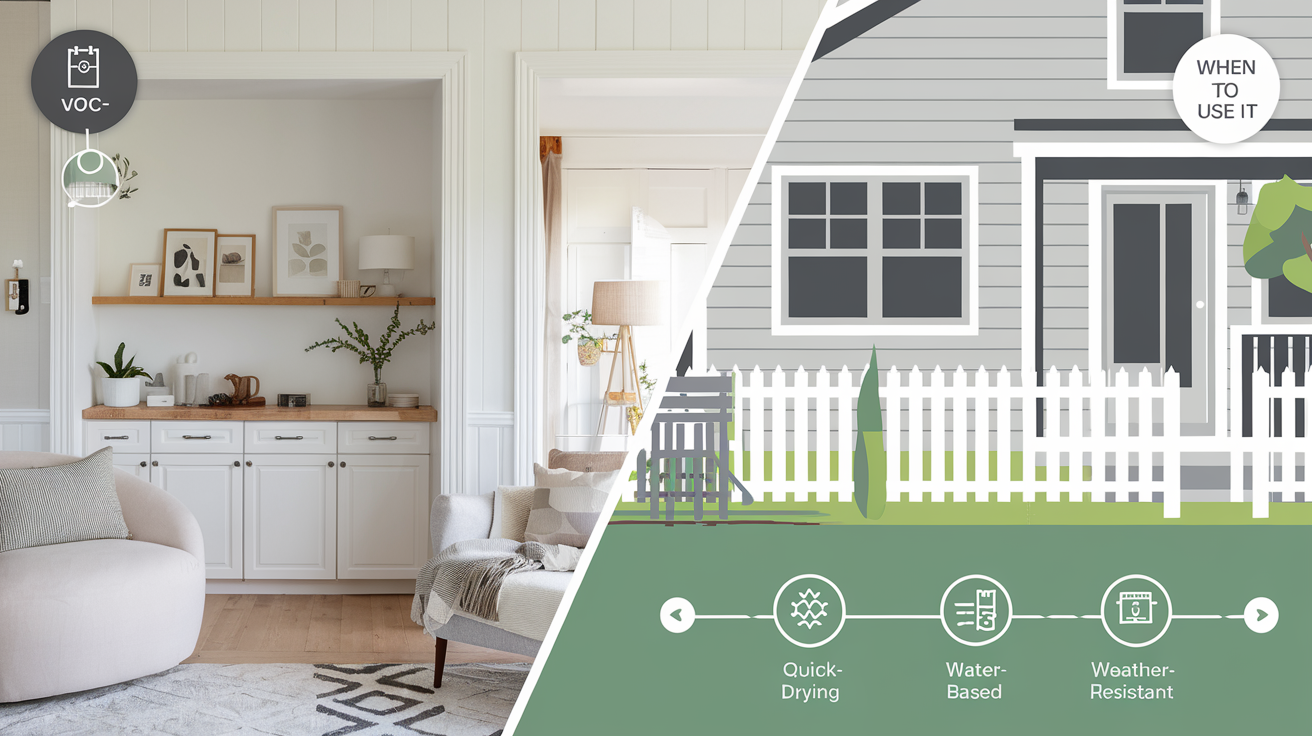
Acrylic latex paint has become a go-to choice for both homeowners and professionals. Its combination of durability, ease of use, and versatility makes it suitable for many different surfaces and situations.
Understanding where this paint performs best will help you make smarter decisions for your next painting project.
Indoor Living Spaces:
Acrylic latex paint is perfect for living rooms and bedrooms because of its low odor. This matters in spaces where you spend most of your time. The paint dries quickly and won’t fill your home with strong fumes.
Kitchens and Bathrooms:
For kitchens and bathrooms, look for acrylic latex marked “kitchen and bath.” These versions offer extra moisture resistance and can stand up to the humidity these rooms face daily. Many are also formulated to resist mildew growth.
Children’s Areas:
Kids’ rooms benefit greatly from acrylic latex paint. It’s washable and holds up to cleaning, which is a must with little ones around. You can wipe off crayon marks, fingerprints, and other small disasters without damaging the paint.
High-traffic zones:
Hallways and stairwells get lots of traffic and touching. Acrylic latex holds up better than standard latex in these high-use areas. It resists scuffing and can be cleaned more often without losing its finish.
Exterior Surfaces:
On siding, acrylic latex resists cracking as temperatures change. It’s flexible enough for trim work too, allowing the wood to expand without the paint failing. Fences painted with acrylic latex keep their color longer against sun exposure.
Outdoor Projects:
Outdoor furniture lasts longer against weather damage when painted with acrylic latex. The paint moves with the materials as they expand and contract, reducing peeling and flaking.
Quick-Turn Project:
Choose acrylic latex when you need to finish a room fast. It’s usually touch-dry in 1-2 hours and can often take a second coat the same day, unlike oil-based options that might need 24 hours between coats.
Not-So-Great Applications:
Very glossy surfaces need proper prep before acrylic latex will stick well. Areas with extremely high humidity, like shower interiors, might need a more specialized product. For metal facing harsh conditions, you might want an oil-based option instead.
Application Tips for Best Results
Getting the most from acrylic latex paint isn’t just about buying the right can. How you apply it makes all the difference between an amateur-looking finish and professional results.
Surface Preparation
- Clean surfaces thoroughly before painting to remove dirt, grease, and dust
- Wash walls with mild soap and water, then rinse well
- Use a degreaser in kitchens to remove cooking residue
- Let the surfaces dry completely (at least 24 hours) before painting
- Sand glossy surfaces lightly with fine-grit sandpaper to help paint grip
- Wipe away all dust with a damp cloth after sanding
Priming Matters
- Use primer on bare wood, drywall, and when making major color changes
- Tint your primer close to your final color when covering dark walls
- Allow primer to dry fully according to the manufacturer’s instructions
Application Techniques
- Use quality brushes and rollers for the best results
- For smooth walls, use rollers with a short nap (3/8 inch)
- For textured surfaces, choose a longer nap (1/2 to 3/4 inch)
- Apply paint in an “N” or “W” pattern with a roller, then fill in with up-and-down strokes
- Paint in sections about 3-4 feet square
- Keep a “wet edge” by not letting the previous section dry before blending in the next area.
- Avoid overloading your brush or roller to prevent drips
- Apply two thin coats rather than one thick coat
Drying and Curing
- Allow proper drying time between coats (check the paint can for specifics)
- Maintain good air flow in the room to speed drying
- Wait at least two weeks before washing newly painted surfaces
Weather Considerations
- For exterior painting, aim for 50-85°F with low humidity
- Ensure no rain is expected for 24 hours after painting
- Avoid painting in direct sunlight to prevent too-quick drying
How to Read Paint Labels Like a Pro
Paint labels pack a lot of information into a small space. Understanding what you’re looking at helps you make smarter choices without relying on sales staff or guesswork.
Base Type
Look for “Acrylic Latex” or “Water-Based” prominently displayed. Some cans might say “100% Acrylic” for higher-quality formulations. If you see “Oil-Based” or “Alkyd,” you’re looking at a different product entirely.
Sheen Level
Sheen affects both appearance and performance. Labels typically show:
- Flat/Matte: No shine, hides wall flaws, but is less washable
- Eggshell/Satin: Slight shine, good for living areas
- Semi-Gloss: Moderate shine, works well in kitchens and bathrooms
- Gloss: High shine, best for trim and doors
Coverage Rate
Find “Coverage” or “Spread Rate,” followed by square feet per gallon. Higher numbers (350-400 sq ft) indicate better coverage than lower numbers (250-300 sq ft).
Drying Time
The labels list both “Dry to Touch” time (usually 1-2 hours for acrylic latex) and “Recoat Time” (when you can apply a second coat).
VOC Content
“VOC” (Volatile Organic Compounds) numbers indicate how many harmful chemicals will be released. Lower is better for indoor air quality. “Zero VOC” or “Low VOC” paints are safest for indoor use.
The Bottom Line
So, is acrylic latex paint water-based? Yes, it absolutely is. Water serves as the carrier for the paint’s acrylic and latex resins, making it easier to apply, quicker to dry, and simpler to clean up than oil-based alternatives.
This water-based formula gives you practical benefits: lower odor, easier cleanup, and better environmental impact. For most home projects, acrylic latex paint offers the perfect balance of durability and user-friendliness.
Next time you’re planning a painting project, check the label for “acrylic latex” or “water-based” and choose the right sheen for your specific needs.
Remember that while it’s water-resistant, it’s not completely waterproof—choose specialized products for areas with constant moisture exposure.


